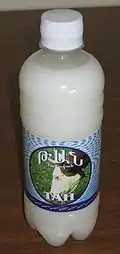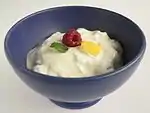Ayran
Ayran, doogh, Dhallë, or tan is a cold savory yogurt-based beverage, popular across the Middle East, Central Asia and Eastern Europe. The principal ingredients are yogurt, water and salt.[1][2][3][4] Herbs such as mint may be optionally added. Some varieties are carbonated.
 | |
| Alternative names | Ayran, Doogh, Dove, Dhallë, Tan or yogurt milk |
|---|---|
| Type | Dairy product |
| Course | Beverage |
| Region or state | Central Asia, Middle East, Balkans |
| Serving temperature | Cold or Lukewarm (depending on preference) |
| Main ingredients | Yogurt, water, salt |
Preparation
Ayran is served chilled and often as an accompaniment to grilled meat or rice,[5] especially during summer.[6] It is made by mixing yogurt with chilled or iced water[7] and is sometimes carbonated and seasoned with mint.[8][9] It has been variously described as "diluted yogurt"[10] and "a most refreshing drink made by mixing yogurt with iced water".[11]
The traditional way of preparing the drink among various Iranic peoples is straight from milk, without yogurt, using a waterskin, known as mashk (مشک) in Luri and Persian in Iran, and maskah (مسکه) in Afghanistan. This is done by pouring the milk in the waterskin, usually made of deer or sheep skin, and shaking it for hours, sometimes using a wooden structure to keep the waterskin above the ground with woolen strings to make the task easier.[12][13]
History
According to Nevin Halıcı, ayran was consumed by Turkic people of Central Asia.[10] A c. 1000 CE Turkish dictionary, Dīwān ul-Lughat al-Turk, defines ayran as a "drink made out of milk.[14] The Turkish word ayran comes from the Proto-Turkic *ajran or *ayran.[15]
Ayran, called doogh in Persian, has long been a popular drink in Iranian cuisine[16][17] and was consumed in ancient Persia (ancient Iran).[18] It is a cold drink of curdled milk and water seasoned with mint,[19] its name (Doogh) derives from the Persian word for milking, dooshidan.[8]
Other similar drinks include ayran in Turkey, t’an in Armenia and lassi in Southern Asia and are popular in Asian countries; however, they can differ from doogh.[20]
Regional names of the drink and its variations are: Albanian: dhallë; Arabic: شنينة šinīna or عيران eayran; Armenian: թան t'an; Azerbaijani: ayran; Bulgarian: айрян Kurdish: dew; Pashto: شلومبې shrombey; Persian: دوغ, romanized: dūgh; Syriac: ܕܘܓ̄ܐ dove; Turkish: ayran.
Variations
Salt, black pepper, dried mint, and lime juice can be mixed in. Diced cucumbers can be added to provide a crunchy texture to the beverage. Some varieties of doogh are carbonated. In Albania and other Balkan countries, this drink is served normally at lunch or dinnertime, normally with rice and kofta.
Turkish national drink status
Recep Tayyip Erdoğan, a Turkish politician who has held the posts of President and Prime Minister, has promoted ayran as a national drink. Speaking at a 2013 WHO Global Alcohol Policy Conference held in Istanbul, Erdoğan contrasted ayran with alcohol, which he claimed was a recent introduction to Turkey.[21]
Nevertheless, sales of ayran in Turkey lags behind other non-alcoholic beverages. According to a 2015 joint statement from the Soft Drink Producers Association, the Sparkling Water Producers Association, and the Milk Producers and Exporters Union of Turkey, ayran consumption during Ramadan had declined every year for the years 2010 to 2015.[22]
In 2015, Turkey's Customs and Trade Ministry, controlled by Erdoğan's party, imposed a 220,000 TL fine (approximately $70,000) on state-owned Çaykur manufacturers, stating that ayran had been "insulted without reason" in one of their advertisements for iced tea, in which the rapper Ceza rapped that ayran makes him sleepy; the ministry halted advertisements of Çaykur's competing ice-tea product.[23]
Gallery
 Ayran served in traditional way with copper cup(maşrapa).
Ayran served in traditional way with copper cup(maşrapa). Doogh with dry mint on it.
Doogh with dry mint on it..jpg.webp) Dew
Dew Bottle of carbonated tan.
Bottle of carbonated tan.
See also
- Borhani, yogurt-based drink from Bangladesh
- Calpis, Japanese yogurt-based soft drink
- Chal, fermented camel's-milk
- Chaas, yogurt-based drink made with yogurt, salt and water, and occasional mint and coriander leaves
- Chalap, beverage consisting of fermented milk, salt, and carbonated water
- Filmjölk, a yogurt drink from Sweden
- Kefir, fermented milk drink made with yeast grains
- Kumis, fermented mare's milk drink[10]
- Lassi, yogurt-based drink from the Indian Subcontinent
- Milkis, Korean carbonated yogurt milk
- Qatiq, fermented-milk beverage
- Yayık ayranı, Turkish soured and churned yogurt-based drink
References
- Tamime, A. Y., ed. (2008). Fermented Milks. John Wiley & Sons. p. 124. ISBN 9781405172387. Archived from the original on 2017-01-16. Retrieved 2016-12-04.
- Jacobson, Sarina; Weiner, Danya (2008). Yogurt: More Than 70 Delicious & Healthy Recipes. Sterling. p. 6. ISBN 978-1402747595.
- Strnadel, Leslie; Erdley, Patrick (2012). Bulgaria. Other Places Travel Guide. Other Places Publishing. p. 58. ISBN 9780982261996. Archived from the original on 2016-12-21. Retrieved 2016-12-04.
- Nazif Shahrani, M. (2013). The Kirghiz and Wakhi of Afghanistan. University of Washington Press. pp. 92–93. ISBN 9780295803784. Archived from the original on 2019-12-12. Retrieved 2016-12-04.
- "Turkish Buttermilk". www.kultur.gov.tr. Ministry of Culture and Tourism, Turkey. Archived from the original on 18 December 2020. Retrieved 5 October 2013.
- Gina Husamettin. "Ayran – Turkish national beverage". balkon3.com. Archived from the original on 12 October 2013. Retrieved 5 October 2013.
- Davis, P. H. (1956). "Lake Van and Turkish Kurdistan: A Botanical Journey". The Geographical Journal. 122 (2): 156–165. doi:10.2307/1790844. JSTOR 1790844.
- Islamic Republic of Iran (26–29 January 2009). Project Document for a Regional Standard for Doogh (CX/NEA 09/5/8) (PDF). Tunis, Tunisia: United Nations. Joint FAO/WHO food standards programme of the FAO/WHO coordinating committee for the Near East. Retrieved 26 June 2011.
- Yildiz Fatih (2010). Development and Manufacture of Yogurt and Other Functional Dairy Products. CRC Press. p. 10. ISBN 9781420082081. Archived from the original on 2016-12-21. Retrieved 2016-12-04.
- Halici, Nevin (27 April 2013). "Turkish Delights". Gastronomica: The Journal of Critical Food Studies. University of California Press. 1 (1): 92–93. doi:10.1525/gfc.2001.1.1.92.
- Lake Van and Turkish Kurdistan: A Botanical Journey P. H. Davis The Geographical Journal, Vol. 122, No. 2 (Jun., 1956), pp. 156–165 Published by: The Royal Geographical Society (with the Institute of British Geographers) Article doi:10.2307/1790844
- "آیین مشک زدن ( استان چهار محال بختیاری )". آپارات - سرویس اشتراک ویدیو. Archived from the original on 2015-11-09. Retrieved 2020-08-28.
- "تهیه لبنیات مثل ماست، دوغ،روغن، و پنیر روستائی کار ساده ی نیست. - YouTube". www.youtube.com. Archived from the original on 2020-08-31. Retrieved 2020-08-28.
- "Ayran". Etimoloji Türkçe (in Turkish). Telif Hakları. Archived from the original on 4 March 2016. Retrieved 31 August 2014.
- Uchiyama, Junzo; Gillam, J. Christopher; Savelyev, Alexander; Ning, Chao (21 May 2020). "Populations dynamics in Northern Eurasian forests: a long-term perspective from Northeast Asia". Evolutionary Human Sciences. 2. doi:10.1017/ehs.2020.11. Archived from the original on 15 November 2020. Retrieved 28 August 2020. "[...] the Proto-Turkic language has developed extensive nomadic pastoralist vocabulary, including terms for [...] dairy products (*ajran ‘a kind of salty yoghurt’ and *torak ‘a kind of cheese or quark’)."
- Nishinari, Katsuyoshi (2019-12-31). Textural Characteristics of World Foods. John Wiley & Sons. ISBN 978-1-119-43079-7. Archived from the original on 2020-12-18. Retrieved 2020-10-31.
Doogh is an Iranian type of traditional fermented dairy-based drinks that is usually produced by mixing set or stirred yogurt and water at the same rate, as well as some aqueous extracts of local herbs, and spices such as thyme.
- Katz, Sandor Ellix (2016). Wild Fermentation: The Flavor, Nutrition, and Craft of Live-Culture Foods, 2nd Edition. Chelsea Green Publishing. p. 117. ISBN 978-1-60358-628-3. Archived from the original on 2020-12-18. Retrieved 2020-10-31.
- Simmons, Shirin (2007). Treasury of Persian Cuisine. Stamford House Publishing. ISBN 978-1-904985-56-3. Archived from the original on 2020-12-18. Retrieved 2020-10-31.
- Grosart, Alexander (17 July 1886). "Soor-doock" and "doogh". The Academy and literature. 30. Blackburn. p. 59. Archived from the original on 18 December 2020. Retrieved 31 October 2020.
- Nishinari, Katsuyoshi (2019-12-31). Textural Characteristics of World Foods. John Wiley & Sons. ISBN 978-1-119-43079-7. Archived from the original on 2020-12-18. Retrieved 2020-10-31.
Doogh consumption is common in Asian countries (e.g. ayran in Turkey, than in Armenia, lassi in southern Asia). However, they may differ from doogh in dilution ratio, rheological characteristics, fat content, and sensory properties.
- "PM says Turkey's national drink is doogh, not beer". Zaman. 27 April 2013. Archived from the original on 2015-11-17.
- "Turks turn away from 'national drink' despite Erdoğan". Zaman. 22 June 2015. Archived from the original on 2015-11-17.
- Çelikkan, Erdinç (9 November 2015). "State-owned tea firm fined 220,000 liras for 'insulting ayran' in ads". Hürriyet.
